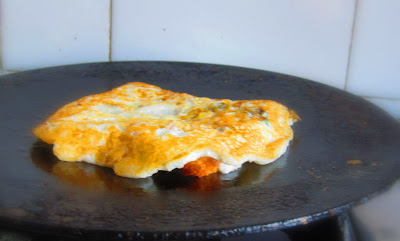When I was young, my mum had two quick-fixes for jolkhabar -- the evening version of the elevenses for a culture that dines late, really late.
Since there's only so much of the evening, and such cartloads of work to do in it, jolkhabar is always tricky. Especially for families like mine, where tastebuds have been coddled such that the ubiquituous Bengali snacks -- like tel-muri, chirabhaja, badambhaja and so on -- had no place on our shelves. To keep rumbling tummies happy, my mother had two fall-back ops. One was a spicy pancake, made by whisking together red onions, chilies, little bits of tomatoes, eggs and milk. We ate it without sweet syrups or honey -- indeed, sweetening this lovely savoury delight never crossed my mind -- but it was delicious.
The other is this, a dish without a real name, referred to always in terms of its methods of preparation. Dim, pauruti chepe. Eggs, with bread pressed on it. And it's so impossibly simple, that I'll let the pictures do the talking.
Good old dim-pauruti chepe. Always comes through in moments of culinary crisis. Like, for instance, at 4AM at the end of the week, when the fridge and larder are both depressingly empty. Or if there are perennially hungry children in the house.
Don't mock it's simplicity, and it will serve your tastebuds and tummy well. Happy emergency eating :-)
Since there's only so much of the evening, and such cartloads of work to do in it, jolkhabar is always tricky. Especially for families like mine, where tastebuds have been coddled such that the ubiquituous Bengali snacks -- like tel-muri, chirabhaja, badambhaja and so on -- had no place on our shelves. To keep rumbling tummies happy, my mother had two fall-back ops. One was a spicy pancake, made by whisking together red onions, chilies, little bits of tomatoes, eggs and milk. We ate it without sweet syrups or honey -- indeed, sweetening this lovely savoury delight never crossed my mind -- but it was delicious.
The other is this, a dish without a real name, referred to always in terms of its methods of preparation. Dim, pauruti chepe. Eggs, with bread pressed on it. And it's so impossibly simple, that I'll let the pictures do the talking.
1. Whisk an egg with a little salt, and chopped green chilies if you like 'em. Pour it in a small circle on a hot, greased tawa/griddle/frying pan.
2. Press a slice of bread on it. My slices of bread always have their crusts cut off, because they hurt my mouth. I'm delicate like that.
3. Now flip the concoction, and let the bread toast on the greasy griddle for a bit.
Transfer onto a warm plate. Sprinkle pepper on top, if you like. I do :-)
Eat!
Good old dim-pauruti chepe. Always comes through in moments of culinary crisis. Like, for instance, at 4AM at the end of the week, when the fridge and larder are both depressingly empty. Or if there are perennially hungry children in the house.
Don't mock it's simplicity, and it will serve your tastebuds and tummy well. Happy emergency eating :-)





































